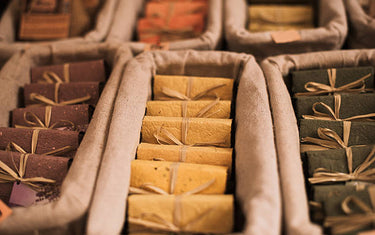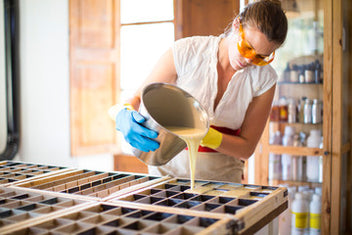7 min read / 1 October 2024 / yasmin sharp
9. Soap Troubleshooting Guide
Discover solutions to common soap-making issues like seizing, cracking, and colour fading with this comprehensive troubleshooting guide for all skill levels.

Soap making is a wonderfully rewarding hobby, yet it can become frustrating and discouraging when soap batter issues arise.
Mistakes are natural, whether you’re a novice or a seasoned soap maker, but understanding the causes of these soap problems can help you find quick and effective solutions.
However, understanding the causes of these problems can help you find effective solutions quickly.
In this guide, we’ll go over some of the most common cold process soap making problems, their causes, and practical cold process soap troubleshooting tips to help you succeed in your craft.

Common Soap Making Troubleshooting Tips
From soap batter issues like seizing to cracks and fading colours, many soap making issues are easy to identify and fix with the right knowledge.
So, let’s explore each potential problem in detail and find out how you can avoid or correct them in your soap making process.
Soap Batter Issues
Seizing
What is seizing in soap making?
Seizing occurs when your soap batter thickens dramatically and unexpectedly, making pouring into the mould difficult or impossible. This often results in soap that looks rough, uneven, or lumpy.

Causes:
- The most common cause is the use of certain fragrance oils, especially those with a high alcohol content.
- Soap batter that is too hot or oils that are too high a temperature can accelerate the reaction.
- Additives like honey or sugar can also cause rapid thickening.
Solutions:
- Add fragrance oils last: This gives you more control over the batter’s consistency and reduces the likelihood of seizing.
- Lower the temperature: Ensure your lye solution and oils are not too hot when combining them. Aim for a temperature around 38°C to 45°C.
- Reduce your water discount: If you find seizing happens often, consider increasing the water content in your recipe.
Acceleration
What does acceleration look like?
Acceleration happens when the soap batter thickens faster than expected, but not as drastically as seizing. You may notice the soap starts to trace very quickly, which means you need to work faster.

Causes:
- Fragrance oils are again a major culprit, particularly floral and spice scents.
- High temperatures can speed up saponification, causing the batter to thicken quickly.
Solutions:
- Use slow-tracing oils: Oils such as olive oil, rice bran oil, or avocado oil slow down trace, giving you more time to work.
- Avoid high-speed blending: Use a spatula or stir stick instead of a stick blender to prevent overworking the batter.
- Adjust fragrance oil usage: Test fragrance oils in small batches to determine if they accelerate trace and choose oils known for slower trace.
Ricing
What is ricing?
Ricing is when your soap batter separates into small, hard lumps, giving it a curdled appearance. This is usually caused by certain fragrance oils or additives reacting poorly with the lye solution.

Causes:
- Problematic fragrance oils, especially if they're synthetic.
- Additives that don’t blend well with your soap batter.
Solutions:
- Stick blend the batter: If you notice ricing, use your stick blender immediately to smooth out the lumps.
- Avoid problematic fragrance oils: If a particular fragrance causes ricing, avoid using it in future batches or use a different oil you know will perform better.
Soap Batter Won’t Reach Trace
If your soap batter seems to stay thin and never reaches a proper trace, the issue could be related to your oil or lye mixture. Check that your lye solution is fresh and correctly measured, as weak or inaccurate lye can prevent saponification.
Using a stick blender at a slightly higher temperature and ensuring a balanced blend of oils can also help your soap reach a stable trace.
Soap Batter Separating or Curdling
When your soap batter separates, you might see layers of oil and water or a curdled texture. This often occurs if the temperatures of your lye and oils differ too much or if certain additives aren’t blending well.
To fix this, try blending the mixture more thoroughly, double-check your temperature ranges, and consider avoiding problematic additives in future batches.
Texture and Appearance Issues
Why Does Soap Crack?
Cracks in soap can be unsightly, but they usually don’t affect the soap’s performance. However, they can be a sign of overheating or issues with your lye solution.

Causes:
- Overheating during the gel phase.
- Using too much lye in the recipe.
- High curing temperatures or a very hot environment.
Solutions:
- Insulate less during the gel phase: If your soap is prone to overheating, reduce the insulation. You can cover your mould with a light cloth instead of heavy blankets.
- Check your lye-to-water ratio: Double-check your recipe’s measurements to ensure you aren’t using too much lye. Too much lye can lead to cracking.
- Place soap in a cooler area: Consider placing your soap in a cooler environment, especially if your curing room gets too warm.
Ashing
What is ashing in soap making?
Ashing refers to the formation of a white, powdery layer on the surface of the soap. While it doesn’t affect the soap’s performance, it can affect its visual appeal.

Causes:
- Excess exposure to air during the curing process causes sodium carbonate to form on the surface.
Solutions:
- Spray with rubbing alcohol: Immediately after pouring, spray the surface of the soap with rubbing alcohol to reduce air exposure.
- Cover with plastic wrap: Place plastic wrap or wax paper over the soap to limit the amount of air that reaches it during the curing process.
Glycerin Rivers
What are glycerin rivers?
Glycerin rivers, also called “crackle,” appear as clear or wavy lines throughout the soap. While some soap makers enjoy the aesthetic, others find it problematic.

Causes:
- High water content and high temperatures during saponification.
Solutions:
- Use a water discount: Reducing the water content in your recipe can prevent the formation of glycerin rivers.
- Lower soaping temperature: Keep your oils and lye solution at a lower temperature to minimise glycerin river formation.
Soft or Oily Soap
What causes soft or oily soap?
Soft or mushy soap, sometimes with an oily layer on top, can be caused by several factors. It can, unfortunately, result in soap that takes much longer to cure or that never hardens properly.
Causes:
- Incorrect measurements of oils or lye.
- Incomplete saponification, which means the soap hasn’t fully turned into soap yet.
Solutions:
- Recalculate your lye amount: Make sure your recipe uses the right amount of lye to saponify the oils completely.
- Allow more curing time: If your soap is soft, give it additional time to cure. Some soaps take longer to harden than others.
- Rebatch if necessary: If your soap remains oily or soft even after curing, you can rebatch it and add additional lye to ensure complete saponification.

Colour and Fragrance Issues
Colour Fading or Bleeding
What happens when colours fade or bleed?
Colour fading occurs when the pigments used in soap lose their vibrancy, while bleeding happens when colours run into each other.
Causes:
- Using non-soap-safe colourants.
- High pH levels in the soap can react with certain colours, causing them to fade.
Solutions:
- Use soap-safe colourants: Check that the pigments or dyes you’re using are specifically designed for soap making.
- Check the pH level: Ensure your soap has the correct pH level so you can prevent colour reactions.
Fragrance Fading or Morphing
What is fragrance fading?
Fragrance fading is when the soap’s scent weakens over time. Fragrance morphing happens when the soap’s scent changes, sometimes dramatically.
Causes:
- Using volatile fragrance oils that don’t hold up well during the soap-making process.
- Adding fragrance at high temperatures, causing the oils to evaporate.
Solutions:
- Use stabilised fragrance oils: Opt for fragrance oils designed to withstand the soap-making process without fading.
- Add fragrance at a lower temperature: Once your soap batter has cooled slightly, add your fragrance oil to prevent it from evaporating.

Lather and Performance Issues
No or Low Lather
Why doesn’t my soap lather?
Poor lather can be a disappointment, especially if you or your customers are expecting a bubbly, foamy soap.
Causes:
- Low levels of lather-producing oils, such as coconut or castor oil.
- A high superfat percentage that leaves too much excess oil in the soap.
Solutions:
- Increase lather-producing oils: Oils like coconut oil or castor oil boost lather in soap. You should adjust your recipe to include a higher percentage of these oils.
- Lower the superfat percentage: Reducing the superfat level in your recipe can improve lather by reducing the excess oils.
Soap Doesn’t Harden
Why is my soap still soft?
Soap that remains soft after the curing period can result from too much water or an incorrect lye ratio.
Causes:
- Too much water in the recipe.
- Incorrect lye-to-oil ratio.
Solutions:
- Rebatch the soap: You can rebatch the soap to remove excess water or add more lye if necessary.
- Allow for a longer curing period: Sometimes, soap simply needs more time to harden. Patience is key in soap making!
Safety and Prevention Tips
Proper Measurements
Accurate measurements are essential for soap making. Always use a digital scale to ensure precision when weighing your oils and lye. This will prevent many common soap making mistakes.
Temperature Control
Keeping your lye and oils at consistent, controlled temperatures will prevent many issues, including seizing, acceleration, and overheating.
Testing and Documentation
Test new ingredients, fragrance oils, and techniques with small batches before applying them to full recipes.
Keep a soap making journal to document your recipes, notes, and observations. This will help you learn from previous batches and troubleshoot more effectively.

In Summary
Soap making is a wonderful craft, but it comes with its challenges. From cracked soap to fading colours, these issues can be frustrating.
However, with the right soap making troubleshooting tips, you can fix most problems and continue creating beautiful, functional soap.
If you use fragrance and essential oils on a regular basis, then you may want to consider signing up for a Nikura wholesale account. You’ll get access to exclusive discounts that will help save you money in the long run.








